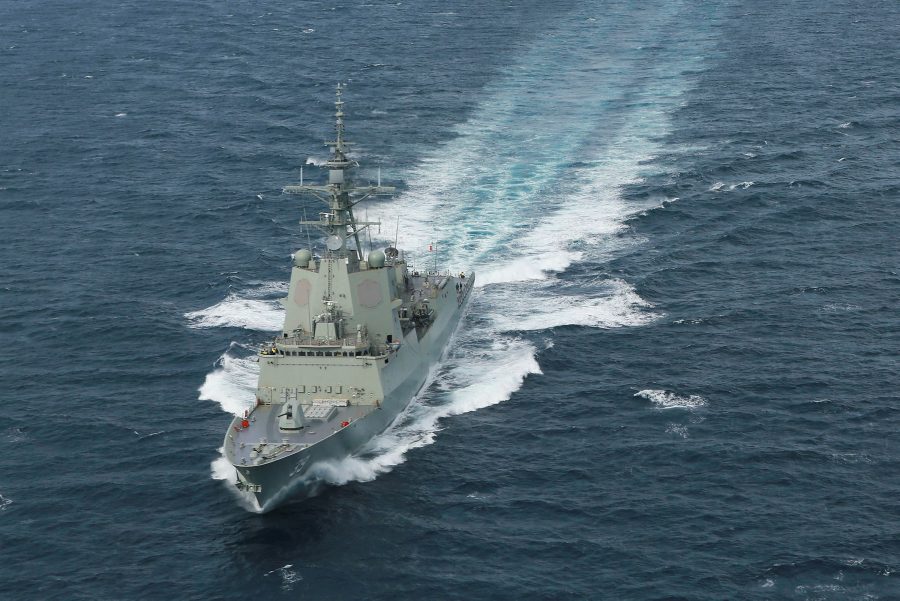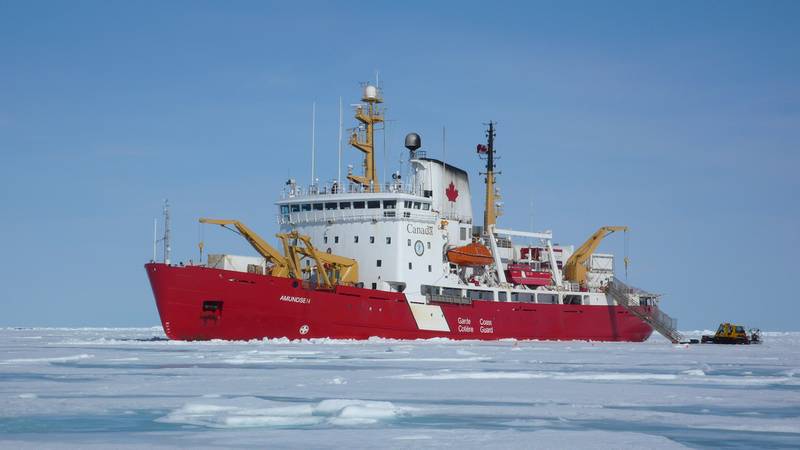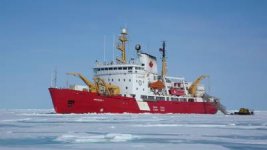Amundsen had a moon pool installed during conversion. Davie built 2 deepsea ships about 5 or 6 years ago with moonpools.Yes the moon pool will allow instrumentation and ROV work while in ice, without the need to cut through the ice. It will be interesting how they do it, not sure there is any other heavy ice breaker out there with one?
You are using an out of date browser. It may not display this or other websites correctly.
You should upgrade or use an alternative browser.
You should upgrade or use an alternative browser.
New Canadian Shipbuilding Strategy
- Thread starter GAP
- Start date
Oldgateboatdriver
Army.ca Fixture
- Reaction score
- 4,321
- Points
- 1,010
Also interesting is the "belt and braces" approach to propulsion - using both "conventional" twin shafts and the "Duel Acting" Azipod along with the bow thrusters.
That should leave lots of options in the ice.
The azipod is your rudder. You could call it an "active rudder", as that concept is used at slow speed on minehunters.
Meanwhile in Oz, since the Hunter frigates program is not delivering combatants until next decade, some analysts start claiming for a second batch of Hobarts.

 www.aspistrategist.org.au
www.aspistrategist.org.au

Delivering a stronger navy, faster | The Strategist
Serious risks are being realised in the Royal Australian Navy’s twin transitions in its surface combatant and submarine fleets. As Australia’s strategic circumstances become more dangerous, Defence needs to adopt hedging measures to actively address ...
- Reaction score
- 7,970
- Points
- 1,160
Forunately they'll be getting their new French Subs at any point....Meanwhile in Oz, since the Hunter frigates program is not delivering combatants until next decade, some analysts start claiming for a second batch of Hobarts.

Delivering a stronger navy, faster | The Strategist
Serious risks are being realised in the Royal Australian Navy’s twin transitions in its surface combatant and submarine fleets. As Australia’s strategic circumstances become more dangerous, Defence needs to adopt hedging measures to actively address ...www.aspistrategist.org.au
We seem to be trading experts; we've imported some of their folks to tell us how to build ships while they are using some of our folks to advise them. If only we had just listed to our own people when they were in the fold, but for some reason no one believes you unless you have a separate letterhead.
- Reaction score
- 12,272
- Points
- 1,160
The azipod is your rudder. You could call it an "active rudder", as that concept is used at slow speed on minehunters.

So those are active rudders and not propulsors?

So those are active rudders and not propulsors?
In this picture are the azipods set for forward sailing I.E. the props pulling rather than pushing? Videos I have seen of azipods on other ships they would point the other way for forward I.E. pushing. I wonder if there is some advantage to mounting the props pulling like this.
- Reaction score
- 12,272
- Points
- 1,160
I understand that with the electric drive the props could pull and push equally effectively.In this picture are the azipods set for forward sailing I.E. the props pulling rather than pushing? Videos I have seen of azipods on other ships they would point the other way for forward I.E. pushing. I wonder if there is some advantage to mounting the props pulling like this.
Also the Double Acting Hull form refers to the fact that the hull was intended to move forward in open water but in ice it was actually intended that it could travel in reverse.
In reverse the propellers pointing forwards would be shielded from the ice.
But.
At the same time the propellers, suitably hardened, could be rotated aft, so that they faced into the oncoming ice and could be used to chew their way through it, adding to the ability of the ship to ride up onto the ice.
- Reaction score
- 12,272
- Points
- 1,160
From the waayback machine
Interesting that the Svalbard only cost the Norwegians 100 MCAD for a one-of-a-kind custom design-build.

 www.army.ca
www.army.ca
Interesting that the Svalbard only cost the Norwegians 100 MCAD for a one-of-a-kind custom design-build.

Naval Icebreakers
I'd like the navy to have its own icebreaker that way we would not have to go through the red tape of using CCG assets. Give it a light gun armament, 2 embarked helicopters and light crago capacity and we could help supply the northern communites while conducting patrols. Waaay back in November...
 www.army.ca
www.army.ca
K/V “Svalbard”
- Coast Guard Ship From Langsten
The new pride of the Navy, K/V “Svalbard” was taken over from Langsten AS on the 15th of December (2001?). The Coast Guard Ship is the Navy’s only ice-breaker and the largest vessel in the whole force. This is Langsten’s build number 182. The ship cost 575 millioner kroner (101 MCAD as of 24 Jan 2006).
…..Minister of Defence Kristin Krohn Devold, with …. Kjell Inge Rokke and other dignitaries ringside. (Rokke owns Aker which in turn owns Langsten). It has taken eight years to realise this vessel, from when the project was begun at SFK in August 1993 to this day. So this was a big day, to have the ship handed over. In 1993 it was intended that the new Coast Guard Vessel should be ready in 1997, but suddenly in 1995 production was stopped. That was a lack of money. Then the force planning guidance de-prioritized the ship and from 1996 until 1998 it was uncertain if the ship would be completed at all. But in 1999 it was put back into the plan again, and in December of that year contracts were let with Langsten. Langsten has a solid tradition of building modern marine vessels. Amongst others the spy ship “Marjata” was built here.
The hull of “Svalbard” was built by Tangen Yards. It is built in special steel and comprises at least 50,000 pieces and 40 sections. By the 17th of February (2000?) the hull was launched and towed to Tomrefjorden in Romsdal, where Langsten finished the vessel.
K/V “Svalbard” is a gigantic vessel with a displacement of some 6300 tonnes, a length of 103 meters and a breadth of over 19 meters making it the Navy’s largest for the foreseeable future.
…….
The Coast Guard
……
K/V “Svalbard” is classified as a Polar 10 Icebreaker by DNV (Det Norske Veritas), the highest polar ice class defined in DNV’s regulations and the most powerful icebreaker ever built in Norway. The vessel is specially built for sailing in ice infested waters, and be able to operate in multi-year (year old?) polar ice with a thickness of up to one meter. The northern Barents Sea, especially in winter time, will be the vessel’s primary area of operation. The ship can also break ice ridges, back up and “screw guard (?)” about four metes deep. (Not clear on this – may have to do with the azipod drive and the ability of similarly designed, double-ended ice-breaking tankers, to turn around and drive through ice backwards).
The vessel has also a De-Ice class notation, being equipped with an anti-icing system with a capacity of 1500 kW. She has got 17 km of heating cable in all outside decks and the front of the boat to this purpose. This prevents icing which can be a great problem in arctic (operations?).
K/V “Svalbard” has a helicopter deck and hangar and will have a helicopter on board when the vessel is out on patrol. In the hangar there is room for two helicopters. The advantage of helicopters is that they can operate freely and relatively far from the vessel. In addition to supervision and control of the fishery violations the helicopter is a really important resource for search, rescue and assistance.
The ship will bring to the Coast Guard many useful capabilities including ice-breaker, towing vessel and helicopter platform. The vessel has really good capacity in search and rescue and can carry through “clean-up” (?) of polluted environments in the extremity (?) (might also just mean that it can continue to operate in a very harsh environment).
Dimensions
Length overall 103.7 m
Length post to post 89.0 m
Greatest width 19.1 m
Draught (KVL) 6.5 m
Tank capacity is about 500 tonnes of fuel oil and 200 tonnes of fresh water. That is enough for 127 persons.
Class: DNV *1A1, Icebreaker Polar 10, RPS, F-A, E0, HELDK-SH, De-Ice, FiFi1.
Machinery
The ship is diesel-electric with a power plant of four Bergen Diesel BRG-8 engines, producing around 13,020 kW altogether. Propulsion is provided by two Azipods, each of 5000 kW, which are classified Icebreaker Polar 10. In addition ABB “provided” (?) a conventional Azipod of about 15 MW power output to obtain this classification. RPS in the class notation means that the ship has “redundant propulsion separated”.
The vessel is also outfitted with a Brunvoll bow-thruster (?). Harbour power generation consists of a Volvo Penta diesel engine of 1071 kW which drives a Stamford generator of 1339 kVa. The pumping system is from Ing. Per Gjerdrum AS, the separators from Westfalia and the compressors from Sperre. Heat exchangers are manufactured by APV and supplied by AS Norco Oslo.
Engine room isolation is by R&M Industries AS and the ventilation is by ABB Miljo. …. is from Pyro and tank monitoring systems by ABB. The engine room is fire-protected with the Argonite system from Heien-Larssen and an alarm system from Autronica.
Deck
The ship is notably outfitted with a helicopter deck and a hangar with room for two helicopters. Also installed onboard is a helifuel-system, with outfitting for refuelling of each helicopter together with other types, both on the heli-deck and in the air. The vessel can therefore function as a mobile platform at sea (and re-provisioning island?) for military and other helicopters on operations that would otherwise not be possible. The advanced foam monitor system on the heli-deck is supplied by Heien-Larssen, but the Fi-Fi system is from Kvaerner Eureka. The heli-deck is also equipped with gyro-stabilised in-flight reference system (light) and contour lighting, “virtually making manning free operations (?)”. Flight Centre has also been instrumented with a datalink to the Norwegian Meteorolgical Institute to supply weather reports.
The deck gear, including hatches, deck machinery such as anchor, vessel and towing winches are supplied by Hydrakraft. The anchor and….is from Erling Haug, windows and light ports from Marine Aluminium, water tight doors from Winell and fire doors from Nor-Pro. Davits from MOB-baten. Deck and Navigation lights? are from Tranberg, searchlight? From Norselight. The ship is instrumented by a system from International Maling.
Interior and Miscellaneous.
The vessel is for a crew of 20 officers and 28 other ranks, with a four-man helidet. In addition the the ship has accommodation for more than 75 persons.
The interior is held “secure” as there is a gas citadel / over-pressure ventilation system where all incoming ship’s air will be scrubbed for radio-active, bacteriological and chemical contamination.
Interior work spaces are outfitted by R&M Industries. TeamTech supplied the incinerator and Evac vacuum toilet system. Electro-technicals consultant was Skan-El, but ABB Installations AS supplied the electric installation. E0-system is the ABB Advant Station 500 series.
The electronic outfit was installed by Electronicon AS. The outfit includes advanced instrumentation with air and surface radar, colour-, black/white and IR cameras, sonar …. for over and under water communication. The system has the capability to record, store and present all this information real-time and time-delay (?), with “intention” (?) of documenting and evaluating incidents. This gives the vessel a good capacity in the role of Command Vessel in large operations in connection with rescue, pollution and sovereignty operations.
- Reaction score
- 16,695
- Points
- 1,160
NSS benefits all of Canada. The CCG ship he mentions is getting a major overhaul at Allied shipyard, not far from my house and this crane in the video arrived last week as I recall. Near the end you can see the boat launching davit that i believe is being prototyped for the CSC.
- Reaction score
- 1,760
- Points
- 1,160
The cost was actually much higher.From the waayback machine
Interesting that the Svalbard only cost the Norwegians 100 MCAD for a one-of-a-kind custom design-build.

Naval Icebreakers
I'd like the navy to have its own icebreaker that way we would not have to go through the red tape of using CCG assets. Give it a light gun armament, 2 embarked helicopters and light crago capacity and we could help supply the northern communites while conducting patrols. Waaay back in November...www.army.ca
- Reaction score
- 147
- Points
- 710
Scraping the bottom of the hull?
Apparently an earlier incarnation of the vessel--see p. 4 PDF here:

Canadian Coast Guard announces an addition to the southern icebreaking fleet with the purchase of light icebreaker from Atlantic Towing Limited
Ensuring that the members of the Canadian Coast Guard have the equipment they need to keep Canada's waterways navigable and safe is a key priority for the Canadian Coast Guard. In support of this priority, the Coast Guard maintains a fleet of icebreakers that operate across Canada, keeping major waterways open to allow for the free movement of people and goods throughout the winter months, ensuring that Canada's economy remains open and strong.
Today, following a competitive process, the Canadian Coast Guard is announcing the purchase of a commercial light icebreaker from New Brunswick-based Atlantic Towing Limited. This vessel will ensure that the Coast Guard retains its icebreaking capacity to keep vital shipping lanes open when the existing fleet enters planned maintenance periods.
The vessel is expected to arrive before the end of the year at its temporary home in Canada at Coast Guard's Prescott base in Ontario. Upon its arrival, CCG will undertake inspection and design work to prepare for the conversion of the vessel in order for it to join the Coast Guard's icebreaking fleet. Public Services and Procurement Canada will issue a public tender for the refit work in early 2022.
Upon joining the Coast Guard fleet, this vessel will perform icebreaking duties as well as tend the Coast Guard's navigational buoys in the Great Lakes, St. Lawrence, and Atlantic regions. In addition, the vessel will be available for search and rescue duties when needed.
Today's announcement represents yet another step forward in the Coast Guard's ongoing fleet renewal planning, and will allow for important services to continue uninterrupted while Coast Guard vessels receive necessary maintenance work.

Canadian Coast Guard announces an addition to the southern icebreaking fleet with the purchase of light icebreaker from Atlantic Towing Limited
Ensuring that the members of the Canadian Coast Guard have the equipment they need to keep Canada's waterways navigable and safe is a key priority for the Canadian Coast Guard. In support of this priority, the Coast Guard maintains a fleet of icebreakers that operate across Canada, keeping major...www.yahoo.com
Apparently an earlier incarnation of the vessel--see p. 4 PDF here:

- Reaction score
- 147
- Points
- 710
Embarrassing headline of the day:Scraping the bottom of the hull?
Apparently an earlier incarnation of the vessel--see p. 4 PDF here:
View attachment 67079
Canadian Coast Guard buys light icebreaker for Great Lakes; vessel currently in Turkmenistan

Canadian Coast Guard buys light icebreaker for Great Lakes; vessel currently in Turkmenistan
Government pays $45 million for vesselwww.wellandtribune.ca
Mark
Ottawa
- Reaction score
- 6,326
- Points
- 1,260
How the heck does one get a ship from the Caspian Sea to Welland Ontario? Up the Volga to Stalingrad and then some canal to the Don and down the Don to the Black Sea?Embarrassing headline of the day:
Mark
Ottawa
Lol, I wonder if someone from CCG is actively cruising Lake Victoria in Africa on the lookout for a used buoy tender that will somehow end up in the Queen Charlotte Islands eventually.
MilEME09
Army.ca Fixture
- Reaction score
- 6,731
- Points
- 1,210
The Caspian sea actually has a canal to the black sea, it's how Russia moves its Caspian flotilla.How the heck does one get a ship from the Caspian Sea to Welland Ontario? Up the Volga to Stalingrad and then some canal to the Don and down the Don to the Black Sea?
Lol, I wonder if someone from CCG is actively cruising Lake Victoria in Africa on the lookout for a used buoy tender that will somehow end up in the Queen Charlotte Islands eventually.
daftandbarmy
Army.ca Fossil
- Reaction score
- 43,412
- Points
- 1,160
The Caspian sea actually has a canal to the black sea, it's how Russia moves its Caspian flotilla.
And there's always a work around...
Russia, Iran again promote alternative to Suez Canal
Russia and Iran are back to promoting the International North-South Transport Corridor as an alternative future option to the Suez Canal after a giant container ship went aground in the canal last month, disrupting global trade traffic for a week.
Read more: Russia, Iran again promote alternative to Suez Canal
- Reaction score
- 147
- Points
- 710
Now 42-year old CCGS Amundsen to be kept going--how long? End of decade before replaced by new icebreaker, presumably built by Davie:Scraping the bottom of the hull?
Apparently an earlier incarnation of the vessel--see p. 4 PDF here:
View attachment 67079
Heddle Shipyards Wins CCGS Amundsen Life Extension Contract
Heddle Shipyards said it has been awarded the vessel life extension of the Canadian Coast Guard icebreaker CCGS Amundsen.
This week, the CCGS Amundsen will arrive at the Port Weller Dry Docks in Canada, the St. Catharines, Ontario, where it will stay through June 2022. The eight-month refit valued at approximately $12,000,000 CAD will sustain over 100 direct jobs and support subcontractors and suppliers across the Niagara Region, Ontario, and Canada.
Heddle Shipyards noted it has also secured the dry docking of a seaway max laker at its Port Weller facility, ensuring a busy 2022 winter work season.
Heddle Shipyards said it will be hiring upwards of one hundred people across all positions to support the single largest project executed by the Port Weller Dry Docks under Heddle Shipyards’ management.
“It is a truly exciting time for us,” said Heddle president Shaun Padulo. “Projects like the CCGS Amundsen help reduce the boom and bust cycle of the ship repair and construction industry in Ontario and will allow us to continue to grow and strengthen our team. We are extremely grateful to the Canadian Coast Guard and the Government of Canada for a project that will support the revitalization of the shipbuilding industry in Ontario.”
CCGS Amundsen is a Pierre Radisson-class icebreaker and Arctic research vessel operated by the Canadian Coast Guard. Built by Burrard Dry Dock in North Vancouver, the vessel entered service in 1979 as Franklin and was renamed Sir John Franklin in 1980 and served as such until 1996. Declared surplus, the vessel was used as an accommodation ship in Labrador in 1996 and placed in reserve in 2000. In 2003, the ship was reactivated and underwent conversion to an Arctic research vessel. The ship recommissioned as Amundsen.
CCGS Des Groseilliers, sister ship to the CCGS Amundsen, was constructed at Port Weller in the early 1980s.

Heddle Shipyards Wins CCGS Amundsen Life Extension Contract
Heddle Shipyards said it has been awarded the vessel life extension of the Canadian Coast Guard icebreaker CCGS Amundsen.This week…www.marinelink.com

Mark
Ottawa
- Reaction score
- 1,760
- Points
- 1,160
I wonder did Davie bid on it?Now 42-year old CCGS Amundsen to be kept going--how long? End of decade before replaced by new icebreaker, presumably built by Davie:
View attachment 67215
Mark
Ottawa
OldSolduer
Army.ca Relic
- Reaction score
- 21,182
- Points
- 1,260
You made this up didn't you....oh never mind..... 45 million????Embarrassing headline of the day:
Mark
Ottawa
This has the potential to become a Monty Python skit
Similar threads
- Replies
- 2
- Views
- 11K
- Replies
- 0
- Views
- 11K
- Replies
- 558
- Views
- 288K
- Article
- Replies
- 121
- Views
- 162K


